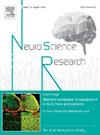桥蛋白介导的病毒靶向小鼠和猴脑内表达μ-阿片G蛋白偶联受体的细胞。
IF 2.4
4区 医学
Q3 NEUROSCIENCES
引用次数: 0
摘要
要了解特定细胞类型在大脑中的功能作用,必须对其进行靶向研究。尽管基因方法可以在动物体内实现细胞类型特异性靶向,但将其应用于高等哺乳动物物种(如非人灵长类动物)仍具有挑战性。在这里,我们开发了一种非转基因方法,利用桥接蛋白将病毒载体导向内源性表达μ-阿片受体(MORs)(一种G蛋白偶联受体)的细胞。桥接蛋白由禽类病毒受体 TVB、MOR 配体 β-内啡肽(βed)和域间连接器组成。EnvB包被的病毒与TVB成分结合,然后βed与MOR相互作用,引发MOR表达细胞中的病毒感染。我们优化了桥接蛋白的分泌信号、结构域排列和域间连接,以最大限度地提高病毒的靶向效率和特异性。结合了不同配体和病毒受体的替代配置也能诱导病毒感染MOR表达细胞。优化的βed-f2-TVB桥接蛋白与EnvB伪型慢病毒一起诱导小鼠和猴子纹状体中表达MOR的细胞感染。将βed-f2-TVB与神经元特异性启动子相结合的交叉方法完善了细胞类型特异性。这项研究为合理的桥接蛋白设计奠定了基础,并证明了靶向酪氨酸激酶受体以外的 G 蛋白偶联受体的可行性,从而扩大了大脑和全身的可靶向细胞类型。本文章由计算机程序翻译,如有差异,请以英文原文为准。

Bridge protein-mediated viral targeting of cells expressing endogenous μ-opioid G protein-coupled receptors in the mouse and monkey brain
Targeting specific cell types is essential for understanding their functional roles in the brain. Although genetic approaches enable cell-type-specific targeting in animals, their application to higher mammalian species, such as nonhuman primates, remains challenging. Here, we developed a nontransgenic method using bridge proteins to direct viral vectors to cells endogenously expressing μ-opioid receptors (MORs), a G protein-coupled receptor. The bridge protein comprises the avian viral receptor TVB, the MOR ligand β-endorphin (βed), and an interdomain linker. EnvB-enveloped viruses bind to the TVB component, followed by the interaction of βed with MORs, triggering viral infection in MOR-expressing cells. We optimized the secretion signals, domain arrangements, and interdomain linkers of the bridge proteins to maximize viral targeting efficiency and specificity. Alternative configurations incorporating different ligands and viral receptors also induced viral infection in MOR-expressing cells. The optimized βed-f2-TVB bridge protein with EnvB-pseudotyped lentiviruses induced infection in MOR-expressing cells in the striatum of mice and monkeys. An intersectional approach combining βed-f2-TVB with a neuron-specific promoter refined cell-type specificity. This study establishes the foundation for the rational bridge protein design and the feasibility of targeting G protein-coupled receptors beyond tyrosine kinase receptors, thereby expanding targetable cell types in the brain and throughout the body.
求助全文
通过发布文献求助,成功后即可免费获取论文全文。
去求助
来源期刊

Neuroscience Research
医学-神经科学
CiteScore
5.60
自引率
3.40%
发文量
136
审稿时长
28 days
期刊介绍:
The international journal publishing original full-length research articles, short communications, technical notes, and reviews on all aspects of neuroscience
Neuroscience Research is an international journal for high quality articles in all branches of neuroscience, from the molecular to the behavioral levels. The journal is published in collaboration with the Japan Neuroscience Society and is open to all contributors in the world.
 求助内容:
求助内容: 应助结果提醒方式:
应助结果提醒方式:


